Weeds, Drought, & Browse Pressure
Gerald Almy
Newcomers to growing forage for deer often picture summer as the best and easiest time for establishing thriving food plots. It’s sunny with mild weather and no frosts or heavy rains to worry about. What could go wrong? The short answer: plenty.
Late summer and into fall is, in fact, usually a better time for achieving the ultimate success with food plots throughout much of the whitetails’ range. First, when planting forages during this time you have plenty of time during the summer to get unwanted weeds killed and have the soil tested, limed, fertilized, and tilled. Autumn rains usually bring plenty of moisture for the newly planted seeds and emerging seedlings, unlike the dry conditions that can often plague summer’s food plots. Thirdly, the forage typically grown during the late summer and fall (mainly brassicas, annual clovers and cereal grains) are all plants that can withstand heavy browsing pressure from deer herds.
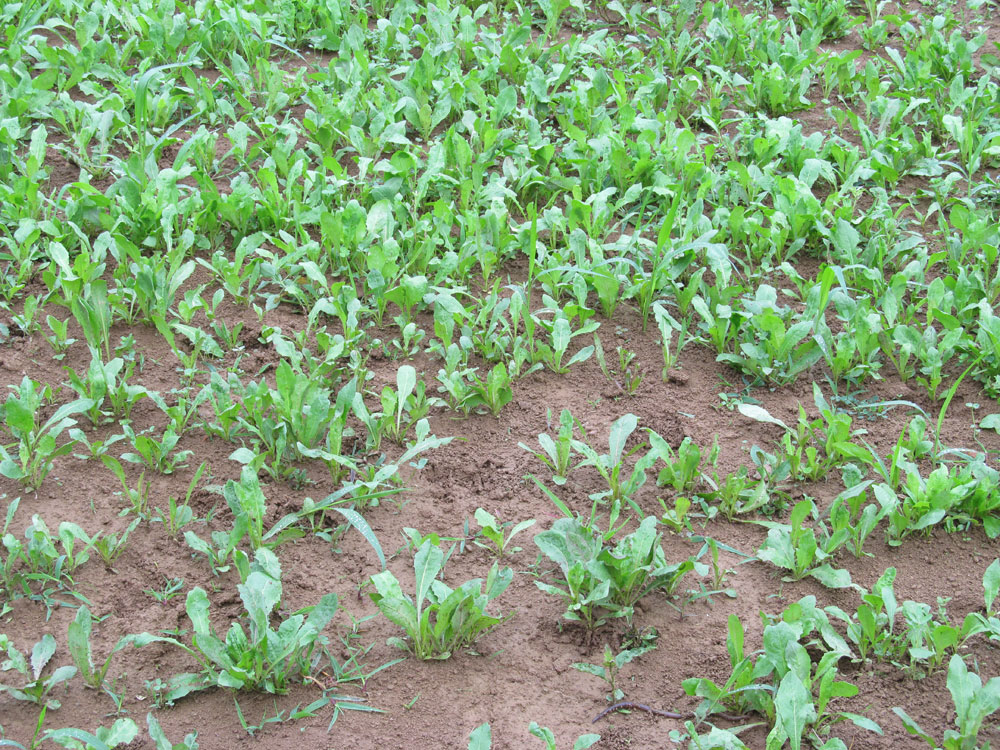
“IT’S ABOUT CREATING A LEGACY FOR ALL FUTURE GENERATIONS. SUBSCRIBE TODAY!”
When planting for summer crops, all three of those late-summer/fall advantages are strikes against you. Fields are often too wet and cold in the spring when you need to get the seed in, cutting short the time available to work the ground, add lime and fertilizers and eradicate weeds. Drought conditions or at least sparse rainfall is common across much of the country during the summer. Thirdly, the crops often grown during June, July, and August (warm season annuals) are particularly susceptible to being over-browsed.
However, skipping summer food plots is not an option – it’s too long to leave the ground idle without providing forage for wildlife. It’s also not good for the soil to leave it with nothing growing. So we learn to adapt and overcome the three big challenges of growing summer food plots - 1) weed competition, 2) drought, and 3) damage to crops from early deer feeding pressure.
I’ve faced all three of these problems of summer food plotting many times over the years, but through lots of trial and error and research I’ve found solutions to overcoming them. Here is the game plan I’ve come up with for solving these three challenges of summer food plots. I hope that some of them will help you enjoy more success this summer.
Fighting Weeds In Summer Food Plots
Unwanted vegetation that chokes out the target crop and robs it of moisture and nutrients is the bane of many summer food plots. Culprits can be both weeds and/or grasses, and the challenge can be complex and ongoing.
First, you must remove as much competition as possible in the potential plot site before planting. Then you must deal with any new competition that may have germinated from the seed bank or any that might have survived and will now compete with the seed you’ve planted. One must be vigilant to combat those weeds that lie hidden in the soil bank and only emerge later in the summer.
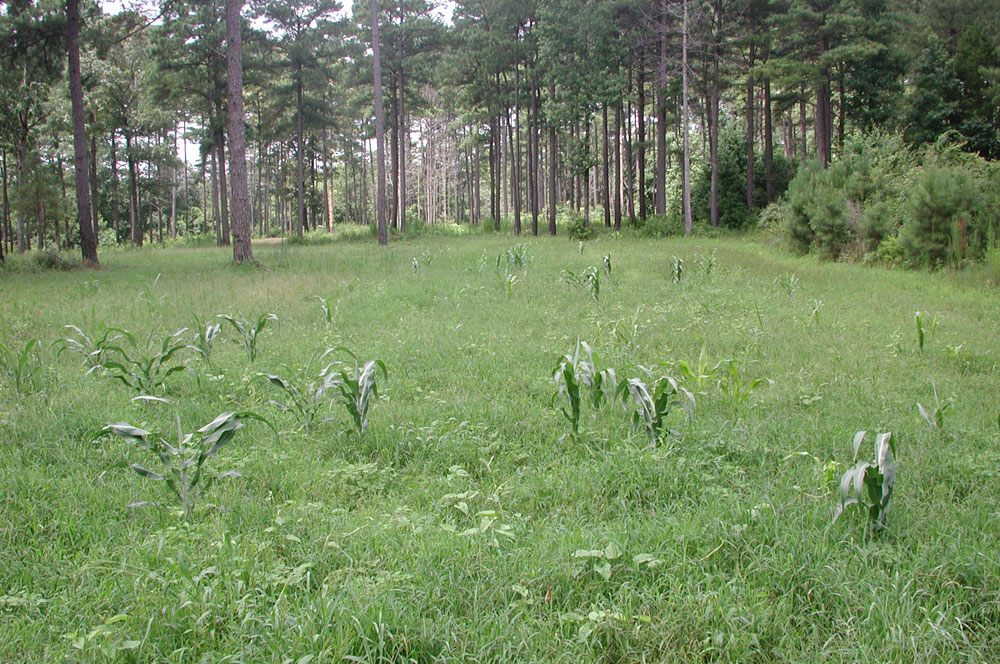
One of the best steps to win the weed war and start right is to first plant a strong-growing annual like brassicas or a Roundup Ready crop that can be treated to kill completion in the site the year before. Brassicas tend to choke out weeds with their fast growth and also release weed-killing glucosinolates. Cereal grains, if planted heavily can also work to keep competition at bay, though not as well as brassicas. Both of these also break up hardpan, and aerate and loosen-up the soil for a future summer plantings. In addition, brassicas will draw nutrients from deep in the soil and leave them at higher levels where the summer crop can make use of them.
Another advance step is to make sure the plot is properly limed and fertilized so the plants can grow quickly and overtake the weed competition. The pH is particularly critical since weeds thrive in acidic soil but most deer forages don’t. Try to bring it up as close to 7.0 as possible and you’ll be a step ahead of the weed potential in the plot.
Avoid working the soil too often. All of us are eager to get out and start working on summer plots, but each time you turn the soil valuable top soil moisture is lost. You should also NOT work the soil if it is too wet. You can’t plow wet soil efficiently, and you’ll likely have to do it again. Compaction and moving more weed seeds into the upper soil level where they can germinate can cause trouble. When practical, till only a couple times.
If weeds are present where you want to put in your summer plot, a non-selective herbicide such as Roundup or generic glyphosate is often the best weapon to start with. No matter what you’re planting, everything will do best in a weed-free site.
I often treat the site, then till, then treat it again with glyphosate after a week or two if additional grasses and weeds appear. Editor in Chief, Todd Amenrud, says he sometimes flips this approach, tilling first, then spraying weeds that remain or emerge a week two later. Lately I’ve been turning more and more to his technique.
During the actual summer growing season after the plot is established, apply selective herbicides such as clethodim or sethoxydim grass control and 2,4-DB (butyric acid) for broadleaf weeds in perennial plots. Unfortunately, neither lablab nor cow peas come in glyphosate-ready versions, but soybeans do, making them a great choice for the ease of controlling weeds during the growing season.
The final step for perennial plots going into clover or clover-chicory mixes is to mow when weeds you missed grow taller than the forage, and especially when seed heads start to form on the unwanted vegetation. This will prevent them from reseeding and overwhelming the plot. As a bonus, this will stimulate your perennials with the emergence of fresh forage that is more tender and higher in protein. Remember not to cut during extremely hot or dry conditions. If you can, try to time mowing just before a rain.
Nothing will rob a summer food plot of its ability to produce more than weeds. Use these various strategies judiciously and you can overcome the first of summer’s big three food plot challenges.
“IF YOU LOVE WILDLIFE AND WANT TO IMPROVE HABITAT, SUBSCRIBE TODAY!”
Summer Food Plot Drought
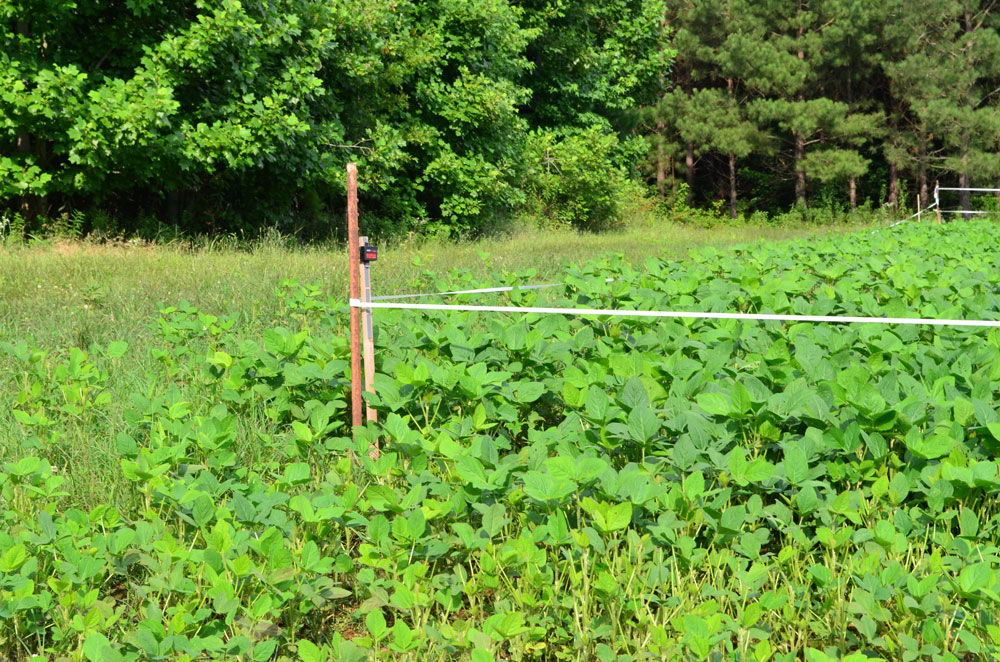
For some of the country, drought or near-drought conditions are almost routine. High temperatures and increasingly long hours of drying sun exposure and it’s no wonder many food plots struggle during July and August.
There are several ways to reduce the problem, beginning with choosing the proper location. Some plots that have tall trees on western and southwestern borders will curtail late afternoon sunlight at the hottest time of day, reducing stress on the plants and moisture loss. Bottomlands often have high-quality soil and typically hold moisture better so it is another prime location for summer plots.
Choosing the right forage to plant is also a vital step. One of the top candidates for drier spots is chicory, either alone or mixed with clovers and other perennials. These plants grow long, deep taproots that can drill down and keep a plot green and attractive during the hottest time of summer when the clovers may slow down and aren’t as productive. The chicory mixed in will keep deer coming even if the clover is a looking a bit wan. Chicory is one of the best plants we have at drawing minerals from the soil and turning them into antler growth.
Lablab, originally from Africa, is a strong candidate for summer plantings. The leaves are larger than cowpeas and it is extremely drought-tolerant. It produces protein levels of 20 to 38-percent, but will typically be finished after your first 30° F night, but without freezing temps it can last well into early fall. From what I’ve seen on my plots, deer rate its palatability extremely high!
Forage soybeans are another prime choice, especially Roundup-Ready versions such as GameChanger Forage Soybeans, where weed control is easy. It simply cannot get too hot for beans. South America’s strong production of this crop is proof of that. Drought also has to be very severe before beans suffer badly. Cowpeas are another fine choice for summer, holding up well in hot, dry weather. All of these annual legumes can be combined with corn, sorghum, sunflowers, or sunn hemp to offer a nurse crop and taller “structure” for the beans and peas to climb.
Sainfoin, a perennial legume often grown in our more arid western states, is extremely drought hardy and can survive with as little as 12-18 inches of rain. It can be mixed with other perennials and does well with birdsfoot trefoil, alfalfa, clovers or chicory.
The final option for combating summer’s drought is using a sprinkler or irrigation system. I’m fortunate to have two wells on my property, one I use exclusively for watering food plots. Using a number of garden hoses hooked together and a round metal-base sprinkler I can water an area 100 feet across. Even if you can’t water all of your summer plots you can target some and they’ll stay extra-green and thrive, making good early season bow-stand sites by concentrating deer on the best forage available. Targeting some crops with irrigation will also take pressure off the other plots you can’t water while they are stressed and struggling from the dry conditions.
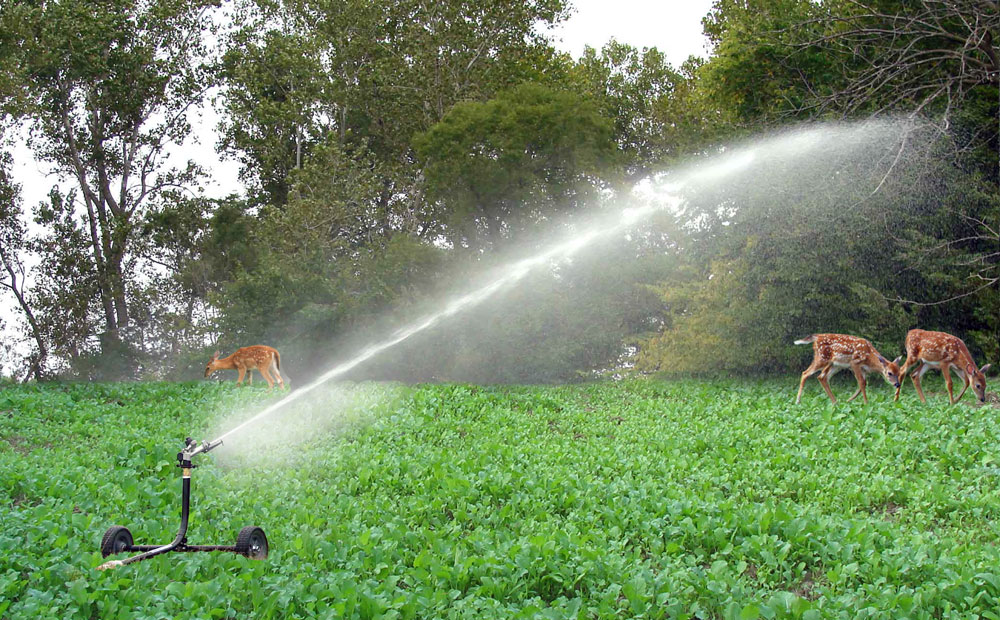
Renting or buying a pump and irrigation system is another option. BigSprinkler.com has whole pump and irrigation setups starting at $1,000. All you’ll need is a water source like a creek or pond. Even if you can’t justify the expense of installing a well, you can rent or buy one of these for use during exceptionally dry periods. That will allow you to “buy time” and save a shriveling up plot until rains arrive that will thoroughly saturate it. Call it “food plot insurance.”
Food Plot Over-Browsing by Deer
I remember well the first time I planted a warm season legume. I picked lablab, and it came up beautifully. The deer in Virginia had never seen it before, so they were wary and left it alone until it was quite an impressive stand of forage.
Finally, one brave doe must have “sampled” it and that was like “ringing the dinner bell.” Whitetails flooded the two-acre field and within days, they had pretty much obliterated it. Some plants came back that year because they were establish enough before the deer obliterated it. The following year they mowed down the seedlings within days after they reached a few inches high.
Stories like this are rampant in the food-plotting world. Fortunately, there are weapons to combat this voracious early feeding on warm season annuals. One preliminary step is to test the soil and apply precisely the right amount of lime and fertilizer, along with micronutrients, to get the strongest growing plants. Those will be more capable of surviving even with some early feeding pressure from deer. It’s also vital to simply plant enough acreage to overwhelm the amount of animals that will be feeding in it. Along the same line, keep the deer herd down to a manageable level - best accomplished in cooperation with your neighbors.
If those steps aren’t enough, here are some other methods for preventing lip-high legumes.
“BECOMING A GAMEKEEPER IS NOT JUST THE BEST WAY TO PRODUCE GREAT HUNTING… IT’S THE BEST LIFE! SUBSCRIBE TODAY.”
The P2 Plot Protector System uses a nylon tape set at a deer’s nose height and soaked in or sprayed with a smell that deer dislike, including ingredients such as cayenne, garlic, and putrescent eggs. The scented tape provides a “wall of scent” that discourages animals from entering the plot.
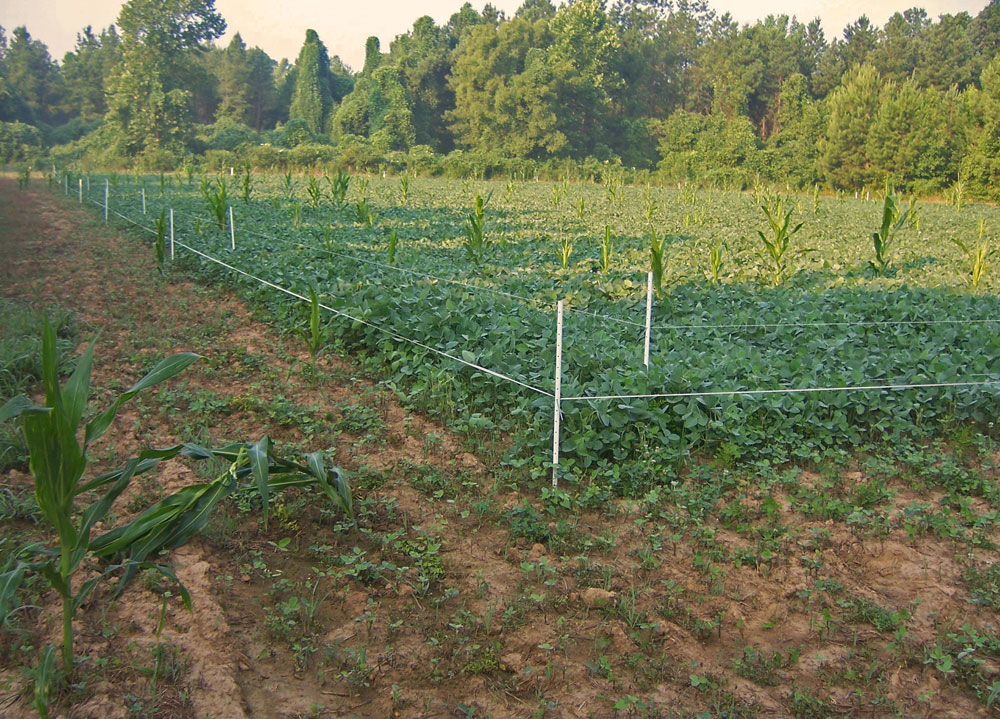
Set the stakes and attach the ribbon around the plot about 30 inches high. Soak or spray the poly tape with the solution. The ribbon itself also offers some visual deterrence. Re-apply the scent after heavy rains. Spraying some of the plants just inside the poly fence also helps ward off animals. In some instances it may be necessary to use a double strand of poly tape offset from the first by about 18 to 24-inches and usually a little higher than the first strand.
Milorganite fertilizer offers another way to discourage deer from attacking an annual. It’s made of biosolids left following processing of sewage sludge. Other similar brands may be available, but this one is manufactured in Milwaukee by a Wisconsin waste treatment plant.
Spread around the outer edge of the plot on all sides, or apply to the whole plot for stronger effect, at approximately 240 pounds per acre. This can discourage deer use for a while until the plants become strong enough to survive some browsing. It is a 5-2-0 fertilizer with 4 percent iron, so it adds some value to the soil. Apply more Milorganite after two weeks to enhance the repellent effect.
Electric fences make for an extremely effective deer deterrent. Varieties of these setups are available, many using a solar charger and battery format. The best results come with staggered dual-perimeter fencing with an 18-inch outer fence and another 14-inch high fence 3-feet inside that to discourage animals from entering. Depth perception problems and the electric shock both sway deer not to enter the plot.
Temporary plastic mesh fences made for vineyards, gardeners and food plotters are another option. These are usually 7-feet high and lightweight versions sell for as little as $20 per 100 feet. Sturdier ones of more durable plastic are quite a bit more expensive, but they can be taken down and rolled up when you want to let deer into the plot, then stored away for next summer.
A method with dual ribbon or poly tape can also work. Put one inner fence 2-3 feet high, then an outer fence 18-24 inches high, 3 feet outside the first fence. This simply uses visual deterrence and a deer’s depth-perception problem to discourage entry. The animals aren’t comfortable jumping across both fences, but don’t know if there’s room enough to land between them and then jump again into the plot. You have to watch borders like these closely – hungry whitetails are hard to dissuade so if you get a breech you must bolster that spot ASAP.
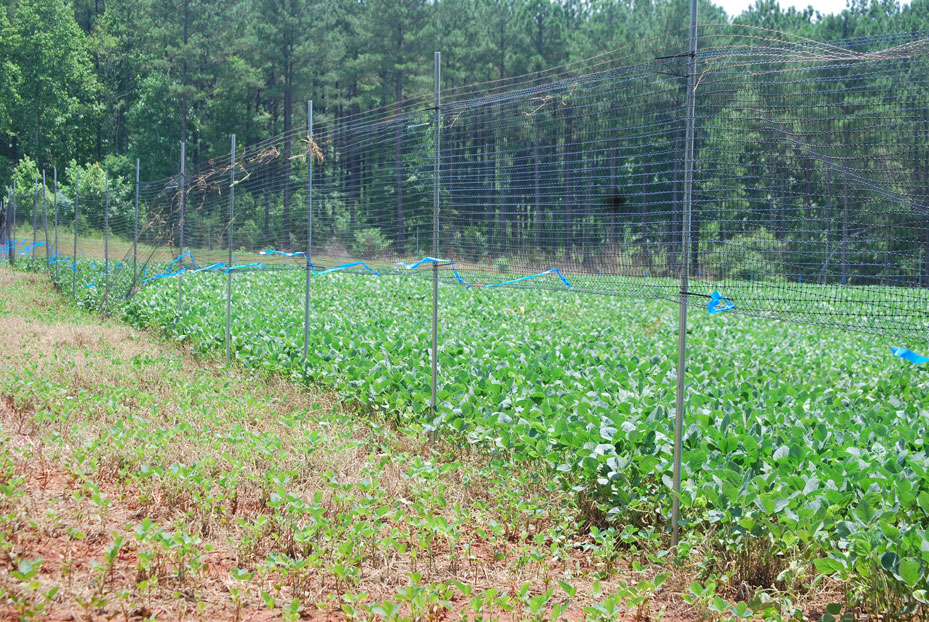
Another approach for reducing deer over-browsing is to add a nurse crop to the extremely attractive cowpeas, lablab, or soybeans you plant. Top choices include corn, sorghum, sunn hemp and sunflowers. The stalks also serve as structure the beans and peas can climb up, allowing them to grow a heavier crop. Their nurse’s primary purpose is to attract the first feeding efforts in the plot so the legumes grow enough so they can withstand browsing pressure. Mossy Oak’s Protein Peas Plus offers a pre-mixed planting with sorghum and sunflower acting as the nurse crops for the iron & clay peas and mung beans.
The final approach to meeting the over-browsing challenge is to simply overwhelm the deer with so much acreage of forage in a single field that no matter how many plants they damage, they simply can’t destroy the whole plot. This often means five or more acres, but if the deer population is relatively low, 3-acre plots may sometimes be enough. Numerous smaller plots can also work well – just make sure there is enough in total to more than satisfy all the animals. Of course, larger spreads make this approach easy. With a 10 to 20-acre field of lablab or soybeans, deer will rarely be able to destroy it all. As they move from plant to plant with the large supply available, they’ll often just nip lightly on one plant and move on, allowing it to continue growing and overcome the minor damage.
The great thing about this approach is deer have access to all the protein-rich forage you’re growing from day one, instead of keeping them out of it with the some of the other deterrence methods. A couple extra weeks of foraging on these high-nutrition plants may add a few inches to a buck’s rack and give does top quality food for producing the best milk for fawns for a longer period. Allowing the deer to feed on the warm season legumes from the start also keeps them satisfied and content to stay on your property. In turn, that allows you to let them reach maturity before harvesting them.































